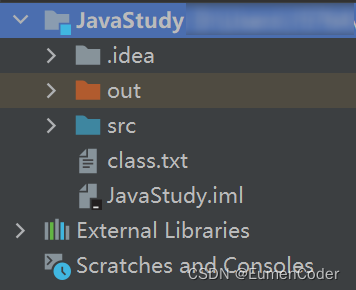反射
定义和功能
定义
反射机制是在
运行状态
中:
对于任何一个类,都能知道这个类的所有属性和方法;
对于任何一个对象,都能调用它的任意一个方法和属性;
功能
(1)在运行时判断任意一个对象所属的类;
(2)在运行时构造任意一个类的对象;
(3)在运行时判断任意一个类所具有的成员变量和方法;
(4)在运行时调用任意一个对象的方法;
(5)生成动态代理;
代码测试
基础接口和类
接口
package reflect;
public interface MyInterface {
void interfaceMethod();
}
类
package reflect;
public class Person implements MyInterface,Myinterface2{
private int id;
private String name;
private int age;
public Person(int id) {
this.id = id;
}
public Person() {
}
public Person(int id, String name, int age) {
this.id = id;
this.name = name;
this.age = age;
}
public int getId() {
return id;
}
public void setId(int id) {
this.id = id;
}
public String getName() {
return name;
}
public void setName(String name) {
this.name = name;
}
public int getAge() {
return age;
}
public void setAge(int age) {
this.age = age;
}
public static void personStaticMethod(){
System.out.println("person类静态方法。。。");
}
private void getPrivateMethod(){
System.out.println("Person类私有方法。。。");
}
@Override
public void interfaceMethod() {
System.out.println("Person类实现MyInterface接口方法。。。");
}
@Override
public void interfaceMethod2() {
}
}
通过反射获取类
//通过反射获取类(3种方式)
//Class.forName()
public void getObject1(){
Class<?> personClass = null;
try {
personClass = Class.forName("reflect.Person");
} catch (ClassNotFoundException e) {
e.printStackTrace();
}
System.out.println("方法1获取person类:"+personClass);
}
//XX.class
public void getObject2(){
Class<Person> personClass = Person.class;
System.out.println("方法2获取person类:"+personClass);
}
//对象.getClass()
public void getObject3(){
Person person=new Person();
Class<? extends Person> personClass = person.getClass();
System.out.println("方法3获取person类:"+personClass);
}
通过反射获取方法
/**通过反射获取方法**/
public void getMethod(){
Class<?> personClass = null;
try {
personClass = Class.forName("reflect.Person");
} catch (ClassNotFoundException e) {
e.printStackTrace();
}
/**可以获取到本类(除private方法外)和父类,接口的全部方法**/
Method[] methods = personClass.getMethods();
Method[] declaredMethods = personClass.getDeclaredMethods();
for (Method method : methods) {
System.out.println(method);
}
/**可以获取到本类的全部方法**/
for (Method declaredMethod : declaredMethods) {
System.out.println(declaredMethod);
}
}
通过反射获取接口
/**通过反射获取接口**/
public void getInterface(){
Class<?> personClass = null;
try {
personClass = Class.forName("reflect.Person");
} catch (ClassNotFoundException e) {
e.printStackTrace();
}
Class<?>[] interfaces = personClass.getInterfaces();
for (Class<?> anInterface : interfaces) {
System.out.println(anInterface);
}
}
通过反射获取私有属性和方法
/**通过反射访问私有属性和私有方法**/
public void getPrivateField(){
Class<?> personClass = null;
try {
personClass = Class.forName("reflect.Person");
} catch (ClassNotFoundException e) {
e.printStackTrace();
}
try {
//创建对象
Person per = (Person) personClass.newInstance();
//获取访问属性和方法
Field id = personClass.getDeclaredField("id");
Method method = personClass.getDeclaredMethod("getPrivateMethod", null);
//打开私有属性和私有方法的访问权限
method.setAccessible(true);
id.setAccessible(true);
//赋值
id.set(per,1);
//调用方法
method.invoke(per,null);
System.out.println(per.getId());
} catch (Exception e) {
e.printStackTrace();
}
}
动态调用
先建立一个class.txt文件,放在项目
最外层目录
下

文件内容:
className=reflect.Person
methodName=getPrivateMethod
动态调用代码:
/**通过反射动态调用**/
public void dynamicLoading() throws Exception {
Properties properties=new Properties();
properties.load(new FileReader("class.txt"));
String className = properties.getProperty("className");
String methodName = properties.getProperty("methodName");
Class<?> personClass = null;
try {
personClass = Class.forName(className);
} catch (ClassNotFoundException e) {
e.printStackTrace();
}
//创建对象
Person per = (Person) personClass.newInstance();
//获取访问属性和方法
Field id = personClass.getDeclaredField("id");
Method method = personClass.getDeclaredMethod(methodName, null);
//打开私有属性和私有方法的访问权限
method.setAccessible(true);
id.setAccessible(true);
//赋值
id.set(per,1);
//调用方法
method.invoke(per,null);
System.out.println(per.getId());
}
版权声明:本文为weixin_42339278原创文章,遵循 CC 4.0 BY-SA 版权协议,转载请附上原文出处链接和本声明。